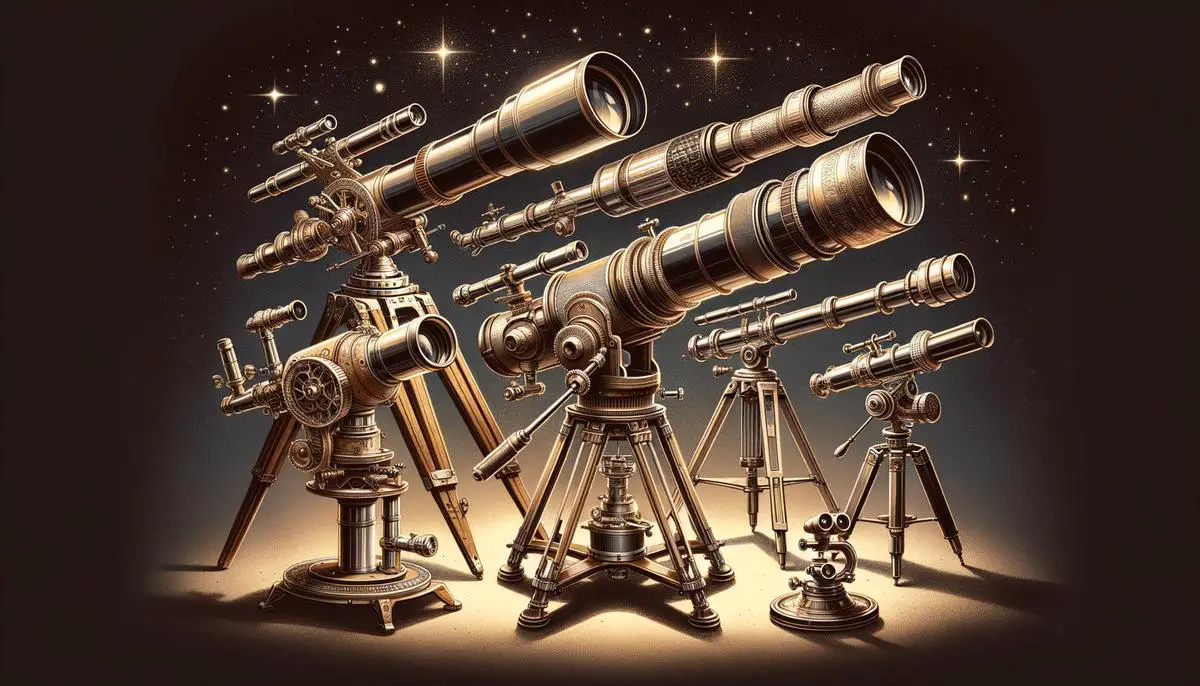Staring up at the night sky, one can’t help but feel a sense of wonder at the vast expanse above. Telescopes act as bridges between us and the cosmic wonders, offering a glimpse into the universe’s secrets. This guide explores various telescopes designed for amateur astronomers, highlighting key features that match different preferences and goals. Understanding the options available is the first step towards making informed decisions in this exciting field.
Types of Amateur Telescopes
Exploring the Universe: A Guide to Telescopes for Amateur Astronomers
The night sky has always been a source of wonder and curiosity, and telescopes serve as our windows to the vast universe. For amateur astronomers, choosing the right telescope is the first step in their journey of discovery. There are three main types of telescopes available: refractors, reflectors, and compound telescopes. Each type offers distinct features and capabilities, catering to different observational interests and budgets.
Refractor Telescopes: Precision and Clarity
Refractor telescopes, also known as dioptric telescopes, employ lenses to gather and focus light. The main lens at the front of the telescope, called the objective lens, bends the incoming light to a focal point, creating an image. This design provides sharp and high-contrast images, making refractor telescopes ideal for observing the moon, planets, and binary stars.
The construction of refractor telescopes means they are generally durable and require little maintenance. However, larger refractor telescopes can be expensive and heavy. The presence of lenses also introduces a phenomenon called chromatic aberration, where colors may not focus at the same point, leading to color fringes around objects. Despite this, refractors remain popular due to their ease of use and the quality of images they produce.
Reflector Telescopes: Power and Versatility
Reflector telescopes, or catoptric telescopes, use mirrors instead of lenses. A large concave primary mirror at the telescope’s back reflects light to a focal point. Some designs then use a secondary mirror to redirect the light to an eyepiece at the side of the telescope.
Reflectors are typically more affordable than refractors of the same aperture size, thanks to the lower cost of producing mirrors compared to lenses. This affordability does not come at the expense of performance; reflector telescopes offer excellent capabilities for observing deep-sky objects like galaxies and nebulae. They are, however, more susceptible to misalignment (known as collimation) and require more maintenance to keep in optimal condition.
Compound Telescopes: Compact Efficiency
Compound telescopes, or catadioptric telescopes, combine lenses and mirrors to create a compact and versatile instrument. The most common types are the Schmidt-Cassegrain and Maksutov-Cassegrain telescopes. These designs utilize both lenses and mirrors to fold the light path, resulting in a smaller, more portable telescope without sacrificing aperture size.
Compound telescopes offer the benefits of both refractors and reflectors, providing good image quality and the ability to observe a wide range of celestial objects. They are particularly suited to those looking for a general-purpose telescope that is easier to transport and store. However, they are usually more expensive than pure reflectors and might not offer the same level of detail on certain astronomical targets due to their hybrid nature.
Choosing the Right Telescope
Selecting a telescope is a personal decision based on interests, budget, and how you plan to use it. For those fascinated by the delicate details of planetary observation, a refractor might be the best choice. Amateur astronomers eager to explore deep-sky objects may find reflectors more to their liking. For a balance between portability, versatility, and observational power, compound telescopes offer a compelling option.
In conclusion, amateur astronomers have a variety of telescope types to choose from, each with its strengths and limitations. Understanding these differences is key to selecting the right telescope that will open up the universe for exploration and enjoyment. Whether it’s refractors with their clear images, reflectors with their deep-sky prowess, or the versatile compound telescopes, there’s a window to the cosmos waiting for every aspiring astronomer.
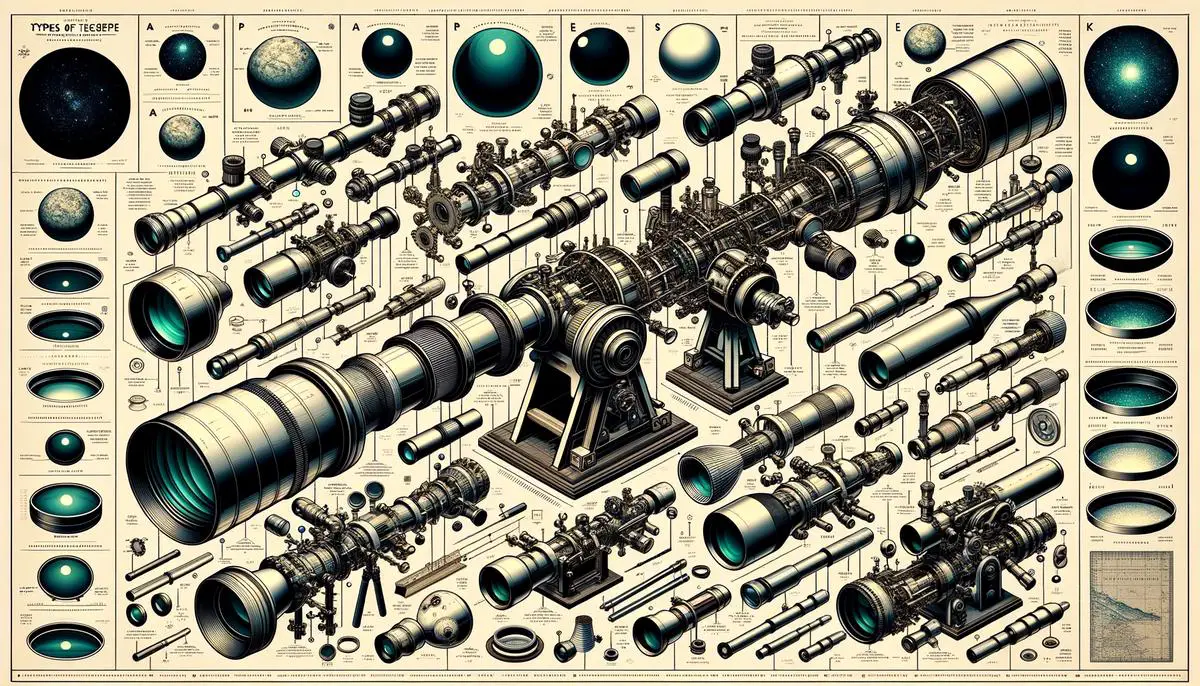
Key Features and Specifications
Understanding Mount Types and Tracking Systems in Amateur Telescopes
In the realm of amateur astronomy, the journey towards acquiring a telescope extends beyond merely selecting the telescope type. An aspect of paramount importance, which often goes underappreciated, involves the choice of mount and tracking system. These components play a crucial role in determining the overall user experience, effectiveness in observing celestial objects, and the level of engagement one can expect from their equipment. Let’s delve into the distinct types of mounts available and the relevance of tracking systems to enhance the observational capabilities of amateur astronomers.
Mount Types: Altazimuth vs. Equatorial
The mount serves as the foundation of the telescope, ensuring stability and facilitating movement across different axes to track celestial objects. Predominantly, there are two types of mounts: Altazimuth and Equatorial.
- Altazimuth Mounts
Basic in design, the altazimuth mount allows for straightforward up-down (altitude) and left-right (azimuth) movements. This intuitive operation makes altazimuth mounts an appealing option for beginners. Its simplicity not only lends itself to ease of use but also contributes to generally lower costs compared to more complex mounts. However, one limitation is the manual effort required to track objects across the sky, particularly at higher magnifications where objects move out of view more rapidly. - Equatorial Mounts
Designed for advanced tracking capabilities, equatorial mounts align with the Earth’s axis, enabling the telescope to follow the natural path of celestial objects across the sky. This alignment is accomplished through adjustment of one of the mount’s axes to match the Earth’s axial tilt. The primary advantage of equatorial mounts lies in their ability to track objects smoothly with minimal manual adjustment, especially beneficial for long-duration observations or astrophotography. The complexity of setting up and properly aligning an equatorial mount, alongside its higher cost, makes it more suited to experienced amateurs.
Tracking Systems: Manual vs. Motorized
Accompanying the choice of mount is the consideration of how the telescope tracks objects as they move due to the Earth’s rotation.
- Manual Tracking
With manual mounts, the observer adjusts the telescope’s position by hand to follow objects in the night sky. This method demands constant attention and adjustment, particularly when observing at high magnifications. For those who appreciate a hands-on approach and the joy of discovery, manual tracking offers a gratifying experience. It also represents a cost-effective solution without the need for electronic accessories. - Motorized Tracking
Telescopes with motorized tracking systems automate the process of following celestial objects. Once an object is located, the motorized system can keep it in view, compensating for the Earth’s rotation. This feature is invaluable for astrophotography, where long exposure times necessitate precise tracking. Additionally, motorized mounts often come with “GoTo” capabilities, automatically locating and tracking objects from an internal database based on user input. While this technology enhances the observing experience and increases the likelihood of successful observations, it comes at an increased cost and requires a power source.
Conclusion: Selecting the Right Mount and Tracking System
The selection of a mount and tracking system is determined by various factors, including one’s level of experience, observational interests, and budget. For beginners and those who prefer a straightforward approach to stargazing, altazimuth mounts with manual tracking offer a practical starting point. Conversely, experienced amateurs or those with a keen interest in astrophotography may find equatorial mounts with motorized tracking to be a worthwhile investment, unlocking advanced capabilities and easing the challenge of tracking objects over extended periods.
In conclusion, understanding the significance of mounts and tracking systems in amateur astronomy empowers individuals to make informed decisions that align with their astronomical ambitions, thereby enhancing their engagement and satisfaction with the celestial exploration journey.
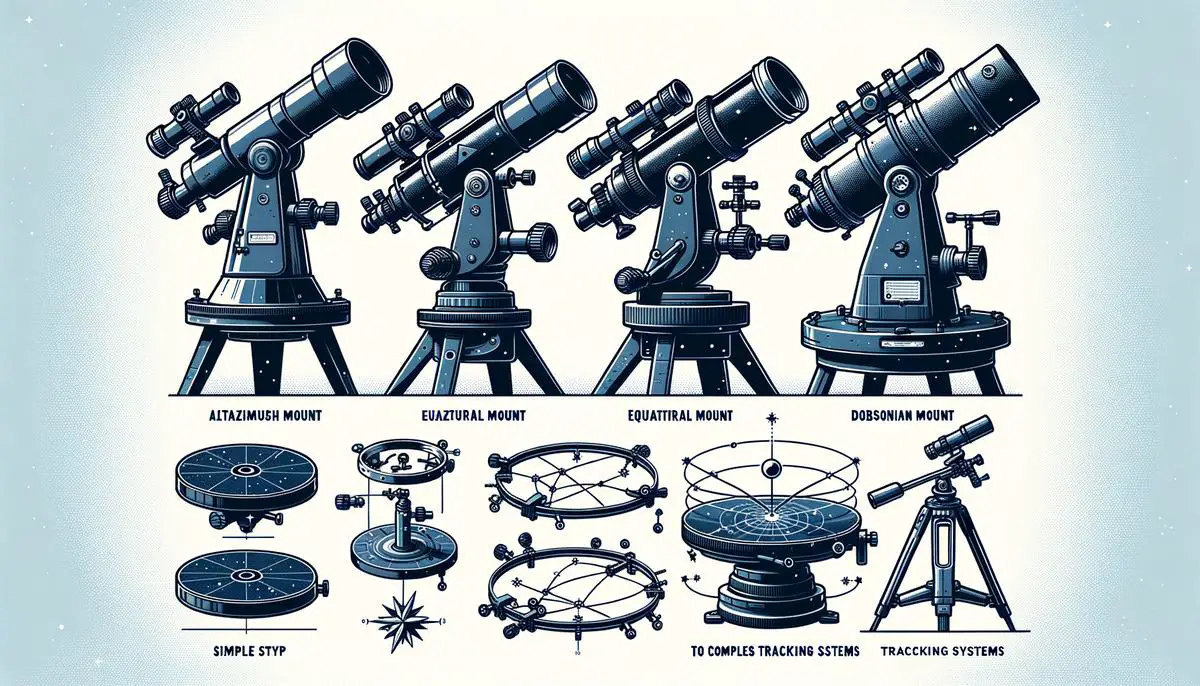
Selecting the Right Telescope
Selecting the right mount and tracking system for your telescope can significantly enhance your stargazing experience. These components are crucial for stabilizing the telescope and navigating the night sky. To make an informed decision, it’s essential to understand the differences and functionalities of each type.
Altazimuth Mounts:
This mount type is straightforward, allowing vertical (altitude) and horizontal (azimuth) movements. It’s particularly user-friendly for beginners due to its simple design and ease of operation. The altazimuth mount is well-suited for ground-based observations and casual stargazing, offering flexibility and speed in moving across different sky regions. However, it doesn’t naturally follow the arc of the night sky, which can limit longer observation sessions or detailed study of celestial objects.
Equatorial Mounts:
Designed for more advanced amateur astronomers, equatorial mounts compensate for the Earth’s rotation. By aligning one axis with the celestial pole, they enable smooth tracking of objects across the sky. These mounts are ideal for astrophotography or long-term observations. The complexity of setting up and aligning an equatorial mount, however, can be a challenge for newcomers. Their weight and bulk might also limit portability.
Manual Tracking:
For those who prefer a hands-on approach or are working within a tight budget, manual tracking allows you to navigate the night sky by manually adjusting your telescope’s position. It’s a good way to learn and understand celestial movement. The downside is the potential for interruptions during observation, as you’ll need to readjust the telescope frequently to keep an object in view.
Motorized Tracking:
Incorporating motors to automatically track celestial bodies, motorized systems offer significant advantages for long-term observation and astrophotography. Once properly aligned, these systems can keep an object centered, providing a more relaxing and uninterrupted experience. The trade-off includes a higher cost and the need for power supply, making the setup less portable and more complex to initially configure.
When choosing between mount types, consider your primary interests in astronomy, the portability you need, and your budget. Beginners might lean towards an altazimuth mount for its simplicity and lower cost, while more experienced users could benefit from the precision of an equatorial mount.
Similarly, your choice between manual and motorized tracking will depend on how much time and effort you want to invest in the act of observation versus watching and imaging. Motorized systems simplify tracking but come at a higher cost and complexity. Manual tracking, on the other hand, is more budget-friendly and offers a hands-on understanding of the night sky’s movements, though it can be less convenient for extended viewing.
Ultimately, the right mount and tracking system for your telescope will align with your personal interests, whether you’re a beginner looking to explore the night sky or a seasoned astronomer focusing on detailed observations or astrophotography. Understanding the capabilities and limitations of each type will help you make a choice that enhances your stargazing journey.
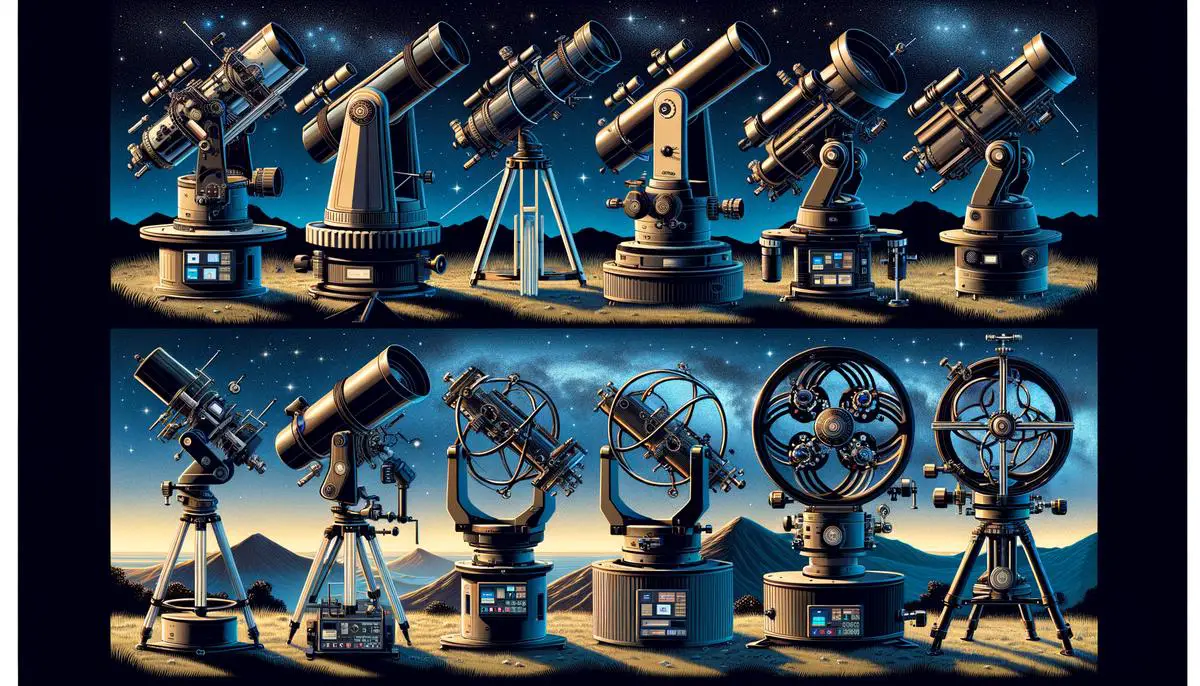
Top Telescope Recommendations and Reviews
Choosing the right telescope is more than just picking a model; it’s about finding a window to the cosmos that best aligns with your curiosity and lifestyle. Amidst the myriad of options, a few telescopes stand out for their exceptional quality, user-friendly designs, and the unique advantages they offer to amateur astronomers. In this guide, we’ll illuminate some top telescope models, breaking down what makes each a worthy companion for your celestial explorations.
1. Celestron NexStar 8SE Telescope
The Celestron NexStar 8SE is a compound telescope that brilliantly synthesizes user-friendliness with sophisticated technology. What makes it particularly appealing is its automated go-to feature, capable of pinpointing over 40,000 celestial objects with precision. This model employs an 8-inch primary mirror, which provides ample light gathering capability, thus offering stunningly clear and detailed images of distant galaxies, nebulae, and star clusters. The NexStar 8SE is well-suited for those who seek a blend of technological advancement with significant imaging power, without the intricate setup often associated with high-end telescopes.
2. Orion SkyQuest XT8 Classic Dobsonian Telescope
Reflecting the essence of a classic Dobsonian design, the Orion SkyQuest XT8 marries simplicity with effectiveness. Its 8-inch aperture reflector allows for excellent clarity and brightness of celestial objects, from the craters of the Moon to the rings of Saturn. A major selling point of this model is its robust design and ease of use, making it an ideal choice for beginners. The telescope’s manual altazimuth mount promotes hands-on learning, offering a visceral, straightforward way to navigate the night sky. This model stands out for those who value simplicity, performance, and the joy of manual discovery.
3. Meade Instruments ETX125 Observer Telescope
A compact powerhouse, the Meade ETX125 Observer is a compound telescope that impresses with its portability and features. It includes a motorized go-to mount, making celestial tracking as effortless as a button click. The 5-inch aperture is deceptively powerful, combining with the optics’ high quality to deliver sharp and bright images of planets and deep-sky objects. Its portability does not compromise its performance, rendering it perfect for those with wanderlust, who dream of stargazing from remote locations without lugging around heavy equipment.
4. Sky-Watcher EvoStar 120 APO Refractor Telescope
Among refractor telescopes, the Sky-Watcher EvoStar 120 is a gem, known for its exceptional color correction and razor-sharp images. This telescope features a 4.7-inch aperture and utilizes an apochromatic lens, which greatly reduces chromatic aberration. It’s a model that appeals to astrophotographers and visual observers alike, offering breathtaking views of planets, the Moon, and vivid deep-sky objects. Its quality build and optical excellence make it a favorite among those who seek premium views and are willing to invest in a higher-tier refractor.
5. Gskyer AZ90600 Telescope
For those just stepping into the vast world of astronomy, the Gskyer AZ90600 provides a harmonious balance of affordability, functionality, and portability. This refractor telescope comes with a smaller 2.36-inch aperture but makes up for it with its ease of setup and use. It includes several eyepieces to vary magnification, an adjustable tripod, and a manual altazimuth mount for hand-controlled movement. This model is particularly suited for families, beginners, and casual stargazers who are looking for an uncomplicated yet rewarding introduction to astronomy.
Each of these telescopes caters to different preferences, reflecting the diversity of the amateur astronomy community. Whether your priority is technological sophistication, user-friendliness, portability, or simply capturing crisp cosmic vistas, there’s a telescope model designed to meet those needs. By understanding the unique features and strengths of each recommendation, you can better navigate the stars and elevate your stargazing experience to new heights.
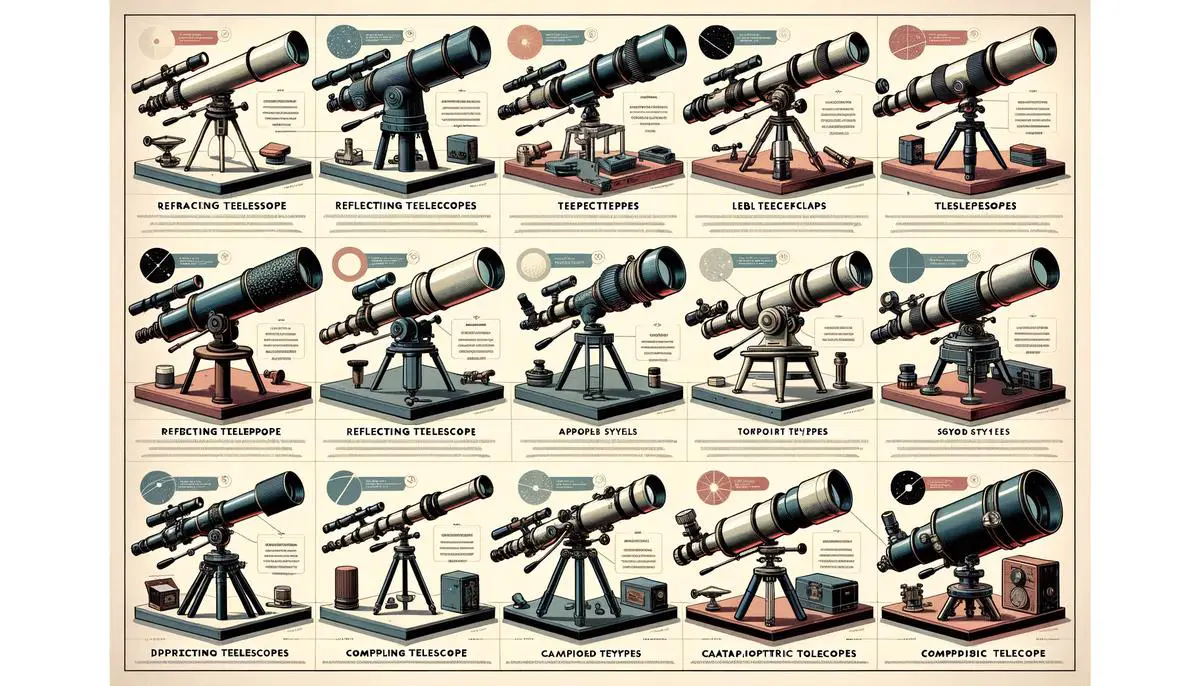
The beauty and complexity of the cosmos are within reach, thanks to the diversity of telescopes available to amateur astronomers. From the crisp, clear images of distant galaxies to the delicate patterns of planetary rings, these instruments open up a world of discovery. The right telescope not only enhances your viewing experience but also connects you more deeply with the wonders of the universe. As you embark on this thrilling venture, remember that the best telescope is the one that meets your specific interests and allows you to engage with the night sky in meaningful ways.
![]()
